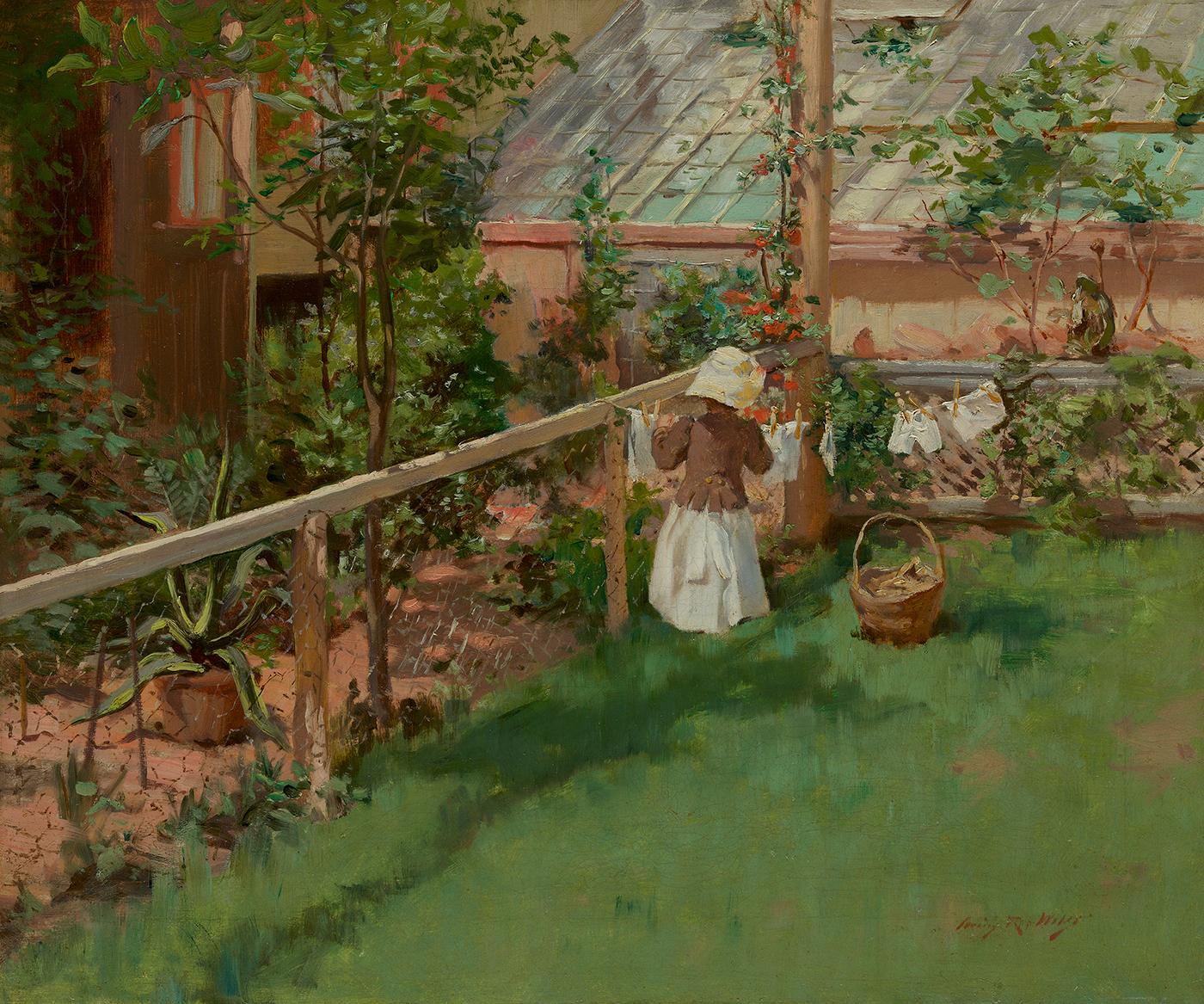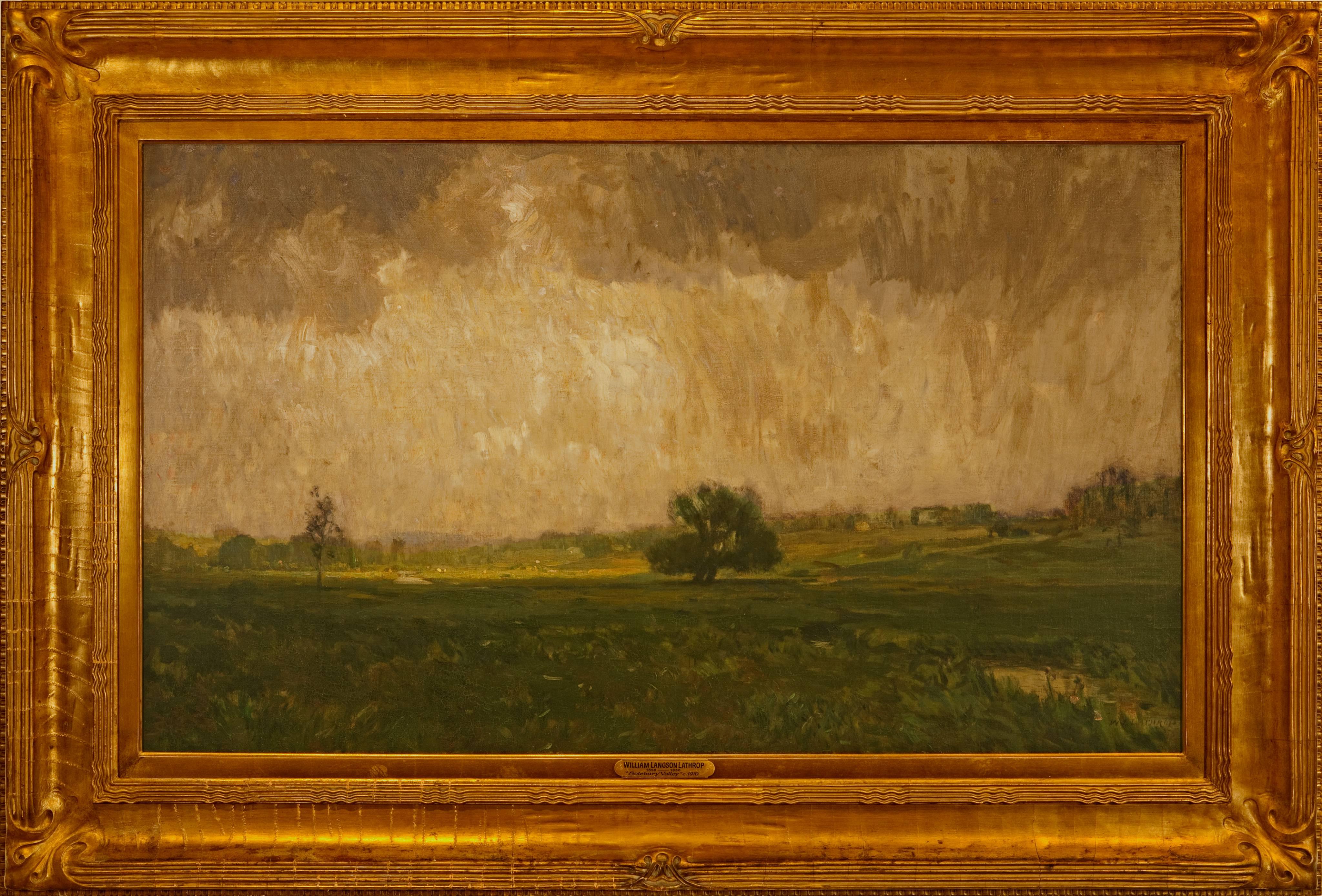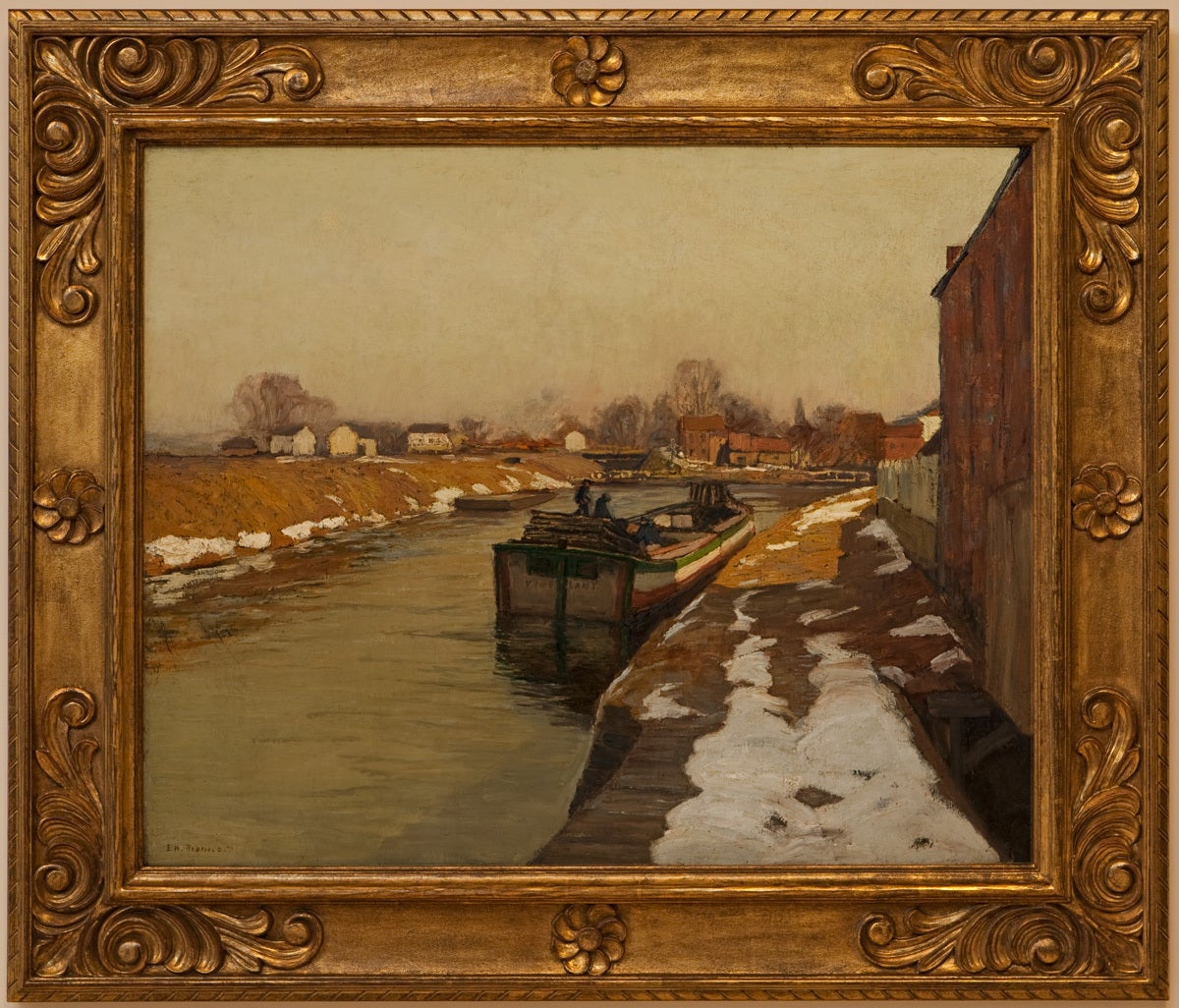Items Similar to Mid Century Sierra Lake and Snow Capped Mountains Landscape
Want more images or videos?
Request additional images or videos from the seller
1 of 10
Elizabeth HubbellMid Century Sierra Lake and Snow Capped Mountains Landscape1960
1960
About the Item
Gorgeous mid-century Sierra Mountains with lake and Redwoods landscape is by Southern California artist Elizabeth Hubbell (American, 1905-1999), c.1960. Signed lower left. Presented in rustic giltwood frame. Image size: 25"H x 30"W. Framed size: 26"H x 29.50"W x 2"D.
Elizabeth Hubbell was a California artist with a 60 year career who was noted for her landscapes. Elizabeth and her daughter Patricia were excellent artists and Elizabeth was noted for her Redwood tree paintings.
- Creator:Elizabeth Hubbell (1905 - 1999, American)
- Creation Year:1960
- Dimensions:Height: 26 in (66.04 cm)Width: 29.5 in (74.93 cm)Depth: 2 in (5.08 cm)
- Medium:
- Movement & Style:
- Period:
- Condition:Professionally cleaned and re-varnished with UV-resistant non-yellowing varnish.
- Gallery Location:Soquel, CA
- Reference Number:
Elizabeth Hubbell
Elizabeth Hubbell was a Californian artist with a 60-year career who was noted for her landscapes. She was well-known for her redwood tree paintings. Elizabeth and her daughter, Patricia, were excellent artists.
About the Seller
4.9
Platinum Seller
These expertly vetted sellers are 1stDibs' most experienced sellers and are rated highest by our customers.
Established in 1986
1stDibs seller since 2014
2,526 sales on 1stDibs
Typical response time: <1 hour
- ShippingRetrieving quote...Ships From: Soquel, CA
- Return PolicyA return for this item may be initiated within 14 days of delivery.
More From This SellerView All
- Country Cottage at SunriseLocated in Soquel, CACountry Cottage at Sunrise Cottage in the morning on a winding path by an unknown American artist. Circa 1930-40. Image 18"H x 15"W Frame, 21"H x 17...Category
1930s American Impressionist Landscape Paintings
MaterialsOil, Canvas
- Monterey Coastal Mountains LandscapeBy Jack LynnLocated in Soquel, CAGorgeous plein air landscape painting of green fields with California mountains and the coast in the background by Monterey area artist Jack Lynn (American, 20th Century). Unframed. ...Category
1990s American Impressionist Landscape Paintings
MaterialsOil, Canvas
- Stable and Corral in the California Hills - 1930sLocated in Soquel, CAHigh Desert Scene at sunrise circa 1930s by Herbert A. Schmidt (American, 1885 - 1930) Schmidt was a well known architect and designer of many San Francisco buildings and was a pupil at the Mark Hopkins Art Institute (SF) in 1899-1901. Graduated from the University of Pennsylvania in Architecture. President of the San Francisco Bohemian Club...Category
1930s American Impressionist Landscape Paintings
MaterialsCanvas, Oil, Illustration Board
- Vintage Downtown Los Gatos, California Street SceneLocated in Soquel, CACharming vintage oil painting of the iconic La Canada Building on the corner of North Santa Cruz Ave and W. Main Street in downtown Los Gatos, California by ...Category
1980s American Impressionist Landscape Paintings
MaterialsCanvas, Oil
- Large Scale Early 20th Century Bucolic Mt. Hood LandscapeBy William M. LemosLocated in Soquel, CAGorgeous landscape with two cows drinking water in a pond with Mt. Hood in background by listed artist William M. Lemos (American, 1861-1942). Signed "W.M. Lemos" lower right. Presented in vintage gilt-toned frame that shows wear (included as-is). Condition: Good: previously owned and used, with little or no signs of wear and is in good condition. No structural issues. Image size: 29"H x 49"W. Born in New York, Professor Lemos moved to San Francisco in 1887 where he established a studio at 106 Geary Street. He later moved to Santa Cruz in 1896, where he settled, painting murals for many local businessmen and the Santa Cruz Beach Boardwalk. As a boy Lemos earned money by wandering the streets and painting on request. Arriving in San Francisco in 1887, he established a studio at 106 Geary. With his wife Mabel, he worked in Los Angeles for a few years in the 1890s. After settling in Santa Cruz in 1896, he painted murals for many local businessmen. When the original Beach Casino was built there at the Boardwalk in 1904, Lemos was the first concessionaire and worked there for nearly 40 years. On his platform in the Casino, Lemos did paintings of redwoods, still lifes, forest fires, beach scenes, and marines. Many of his oils were done on redwood slabs which were popular with the tourists; in the early days these paintings sold for one dollar and up depending on the size of the work. After his vision failed and he was unable to paint, his last years were mostly spent fishing off the Municipal Pier with a friend who baited his hook for him because he could no longer see. In the March 27, 1941 Santa Cruz Sentinel News Lemos reminisced, "Them were the days when the Boardwalk was only twelve feet long and when business got slow I picked up my shotgun and went across the street and shot ducks where the Casa del Rey Hotel now stands." Exhibited: Calif. State Fair, 1885; Mechanics' Inst. (SF), 1889. In: Santa Cruz City Museum; Wawona Hotel (Yosemite). Edan Hughes, "Artists in California, 1786-1940" His mother was Julia Lemos, a Chicago artist famous for her depiction of the Chicago fire, “Two of Julia’s children became successful artists. Her eldest son, William, was a naïve still life, landscape, and mural painter. As a young boy in New York, he would wander the streets, earning money for the family, by ‘painting on request.’ At age 26, William moved to San Francisco, California. He opened an art studio and kept it running until he moved to Santa Cruz with his wife, Mabel, in 1896. During this period, he worked as a fresco artist painting ‘murals for many local businessmen.’ Exhibited California State Fair, Sacramento, 32nd annual, per Sacramento Daily Union, September 9, 1885. and article goes on to say “William Lemos and wife, Sacramento – Art school exhibits in which are shown such a variety of designs in decorative art, flower painting, and ornamentation, that one must give time to the examination.” Exhibited Mechanics Institute, San Francisco, 1889. “Lemos and his wife were in Fresno California 1890...Category
Early 20th Century American Impressionist Landscape Paintings
MaterialsOil, Canvas
- Carriage at Old Mexico Village Dress Shop oil paintingBy Harold Rowan HughesLocated in Soquel, CACarriage at Old Mexico Village Dress Shop oil painting Beautiful mid century impressionist depiction of a Old World Mexico Village Dress Shop and Horse D...Category
Mid-20th Century American Impressionist Landscape Paintings
MaterialsCanvas, Oil
You May Also Like
- At the ClotheslineBy Irving Ramsey WilesLocated in New York, NYSigned lower right: Irving R. WilesCategory
Late 19th Century American Impressionist Landscape Paintings
MaterialsCanvas, Oil
- "Alley Fiends"By John R. GrabachLocated in Lambertville, NJJim’s of Lambertville is proud to offer this artwork by: John R. Grabach (1886 - 1981) John Grabach was a highly regarded New Jersey artist, teacher, and author of the classic text...Category
1930s American Impressionist Landscape Paintings
MaterialsCanvas, Oil
- "Forest Strongholds"By John F. CarlsonLocated in Lambertville, NJSigned lower right. Complemented by a hand carved and gilt frame. Exhibited at the National Academy of Design, 1928Category
20th Century American Impressionist Landscape Paintings
MaterialsCanvas, Oil
- "Solebury Valley"By William Langson LathropLocated in Lambertville, NJSigned lower right. Complemented by a period frame. William L. Lathrop (1859-1938) Deemed “Father of the New Hope Art Colony”, William Langson Lathrop was born in Warren, Illinois. He was largely self-taught, having only studied briefly with William Merritt Chase in 1887, at the Art Students League. Lathrop first moved east in the early 1880s, and took a job at the Photoengraving Company in New York City. While there, he befriended a fellow employee, Henry B. Snell. The two men became lifelong friends and ultimately, both would be considered central figures among the New Hope Art Colony. Lathrop's early years as an artist were ones of continuing struggle. His efforts to break through in the New York art scene seemed futile, so he scraped enough money together to travel to Europe with Henry Snell in1888. There he met and married an English girl, Annie Burt. Upon returning to New York, he tried his hand at etching, making tools from old saw blades...Category
1910s American Impressionist Landscape Paintings
MaterialsCanvas, Oil
- Winter MoonlightBy George William SotterLocated in Lambertville, NJsigned lower rightCategory
1910s American Impressionist Landscape Paintings
MaterialsCanvas, Oil
- "The Canal"By Edward Willis RedfieldLocated in Lambertville, NJJim’s of Lambertville is proud to offer this artwork. Signed lower left. Complemented by a hand carved and gilt frame. Illustrated in "Edward Redfield: Just Values and Fine Seeing" by Constance Kimmerle and the Pennsylvania Academy of the Fine Arts's Exhibition of Paintings by Edward Redfield (April 17 to May 16, 1909) brochure Edward Willis Redfield (1869 - 1965) Edward W. Redfield was born in Bridgeville, Delaware, moving to Philadelphia as a young child. Determined to be an artist from an early age, he studied at the Spring Garden Institute and the Franklin Institute before entering the Pennsylvania Academy from 1887 to 1889, where he studied under Thomas Anshutz, James Kelly, and Thomas Hovenden. Along with his friend and fellow artist, Robert Henri, he traveled abroad in 1889 and studied at the Academie Julian in Paris under William Bouguereau and Tony Robert-Fleury. While in France, Redfield met Elise Deligant, the daughter of an innkeeper, and married in London in 1893. Upon his return to the United States, Redfield and his wife settled in Glenside, Pennsylvania. He remained there until 1898, at which time he moved his family to Center Bridge, a town several miles north of New Hope along the Delaware River. Redfield painted prolifically in the 1890s but it was not until the beginning of the twentieth century that he would develop the bold impressionist style that defined his career. As Redfield’s international reputation spread, many young artists gravitated to New Hope as he was a great inspiration and an iconic role model. Edward Redfield remained in Center Bridge throughout his long life, fathering his six children there. Around 1905 and 1906, Redfield’s style was coming into its own, employing thick vigorous brush strokes tightly woven and layered with a multitude of colors. These large plein-air canvases define the essence of Pennsylvania Impressionism. By 1907, Redfield had perfected his craft and, from this point forward, was creating some of his finest work. Redfield would once again return to France where he painted a small but important body of work between 1907 and 1908. While there, he received an Honorable Mention from the Paris Salon for one of these canvases. In 1910 he was awarded a Gold Medal at the prestigious Buenos Aires Exposition and at the Panama-Pacific Exposition of 1915 in San Francisco, an entire gallery was dedicated for twenty-one of his paintings. Since Redfield painted for Exhibition with the intent to win medals, his best effort often went into his larger paintings. Although he also painted many fine smaller pictures, virtually all of his works were of major award-winning canvas sizes of 38x50 or 50x56 inches. If one were to assign a period of Redfield’s work that was representative of his “best period”, it would have to be from 1907 to 1925. Although he was capable of creating masterpieces though the late 1940s, his style fully matured by 1907 and most work from then through the early twenties was of consistently high quality. In the later 1920s and through the 1930s and 1940s, he was like most other great artists, creating some paintings that were superb examples and others that were of more ordinary quality. Redfield earned an international reputation at a young age, known for accurately recording nature with his canvases and painting virtually all of his work outdoors; Redfield was one of a rare breed. He was regarded as the pioneer of impressionist winter landscape painting in America, having few if any equals. Redfield spent summers in Maine, first at Boothbay Harbor and beginning in the 1920s, on Monhegan Island. There he painted colorful marine and coastal scenes as well as the island’s landscape and fishing shacks. He remained active painting and making Windsor style furniture...Category
Early 1900s American Impressionist Landscape Paintings
MaterialsCanvas, Oil
Recently Viewed
View AllMore Ways To Browse
Snow Landscapes
Landscape With Snow
Snow Landscape Paintings
Landscape Paintings With Snow
Lake And Mountains
California Mountain Landscapes
Mountain Snow
Snow Tree
Caps Painting
Mountain Lake Painting
Trees With Snow
Lake And Mountain Landscape
Snow Mountain Art
Lake And Trees Painting
Redwood Used
Oil Impressionist Landscape Lake
Midcentury California Artist 1960
Snow Mountain Painting






